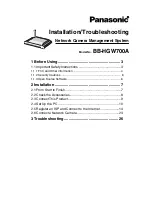
2000 Sep 06
16
Philips Semiconductors
Magnetoresistive sensors for
magnetic field measurement
General
sin
φ =
(6)
where |H
y
|
≤
|H
0
+ H
x
| and H
x
and H
y
are the components
of the external field. In the simplest case H
x
= 0, the volt-
ages U
x
and U
y
become:
U
x
= ρ
⊥
l
(7)
U
y
= ρ
⊥
l
(8)
(Note: if H
x
= 0, then H
0
must be replaced by
H
0
+ H
x
/cos
φ
).
Neglecting the constant part in U
x
, there are two main
differences between U
x
and U
y
:
1. The magnetoresistive signal U
x
depends on the
square of H
y
/H
0
, whereas the Hall voltage U
y
is linear
for H
y
« H
0
.
2. The ratio of their maximum values is L/w; the Hall
voltage is much smaller as in most cases L » w.
Magnetization of the thin layer
The magnetic field is in reality slightly more complicated
than given in equation (6). There are two solutions for
angle
φ
:
φ
1 < 90˚ and
φ
2 > 90˚ (with
φ
1 +
φ
2 = 180˚ for H
x
= 0).
Replacing
φ
by 180˚ -
φ
has no influence on U
x
except to
change the sign of the Hall voltage and also that of most
linearized magnetoresistive sensors.
Therefore, to avoid ambiguity either a short pulse of a
proper field in the x-axis (|H
x
| > H
k
) with the correct sign
must be applied, which will switch the magnetization into
the desired state, or a stabilizing field Hst in the
x-direction can be used. With the exception of H
y
« H
0
, it
is advisable to use a stabilizing field as in this case, H
x
values are not affected by the non-ideal behaviour of the
layer or restricted by the so-called ‘blocking curve’.
The minimum value of H
st
depends on the structure of the
sensitive layer and has to be of the order of H
k
, as an
insufficient value will produce an open characteristic
(hysteresis) of the sensor. An easy axis in the y-direction
leads to a sensor of higher sensitivity, as then
H
o
= H
k
−
H
d
.
Linearization
As shown, the basic magnetoresistor has a square
resistance-field (R-H) dependence, so a simple
magnetoresistive element cannot be used directly for
linear field measurements. A magnetic biasing field can
be used to solve this problem, but a better solution is
linearization using barber-poles (described later).
Nevertheless plain elements are useful for applications
using strong magnetic fields which saturate the sensor,
where the actual value of the field is not being measured,
such as for angle measurement. In this case, the direction
of the magnetization is parallel to the field and the sensor
signal can be described by a cos
2
α
function.
Sensors with inclined elements
Sensors can also be linearized by rotating the current path,
by using resistive elements inclined at an angle
θ
, as
shown in Fig.18. An actual device uses four inclined
resistive elements, two pairs each with opposite
inclinations, in a bridge.
The magnetic behaviour of such is pattern is more
complicated as M
o
is determined by the angle of inclination
θ
, anisotropy, demagnetization and bias field (if present).
Linearity is at its maximum for
φ
+
θ ≈
45˚, which can be
achieved through proper selection of
θ
.
A stabilization field (H
st
) in the x-direction may be
necessary for some applications, as this arrangement only
works properly in one magnetization state.
H
y
H
o
H
x
cos
φ
------------
+
--------------------------
L
wt
------
1
∆ρ
ρ
-------
1
H
y
H
0
-------
2
–
+
1
t
---
∆ρ
ρ
-------
H
y
H
0
-------
1
H
y
H
0
⁄
(
)
2
–
Fig.18 Current rotation by inclined elements
(current and magnetization shown in
quiescent state).
handbook, halfpage
MBH613
M0
M0
Ι
Ι
ϑ
ϑ
ϕ
ϕ














































